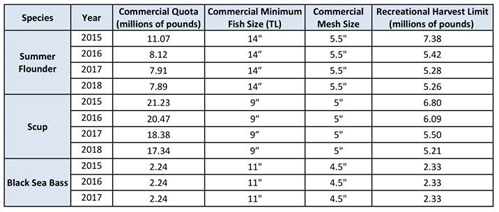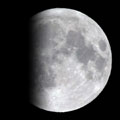Fluke Quota To Be Cut
29 Percent in 2016
From the Atlantic States Marine Fisheries Commission:
FOR IMMEDIATE RELEASE, AUGUST 17, 2015
PRESS CONTACT, TINA BERGER, 703.842.0740
ASMFC & MAFMC Approve
Summer Flounder, Scup, Black Sea Bass
and Bluefish Annual Specifications
New York, NY – The Atlantic States Marine Fisheries Commission (Commission) and the Mid-Atlantic Fishery Management Council (Council) have established specifications for the summer flounder, scup, black sea bass and bluefish fisheries.
The Commission’s actions are final and apply to state waters (0-3 miles from shore). The Council will forward its recommendations for federal waters (3 – 200 miles from shore) to NOAA Fisheries Greater Atlantic Regional Fisheries Administrator for final approval.
The table below summarizes commercial quotas and recreational harvest limits for summer flounder, scup and black sea bass (2015 values are provided for comparison purposes). Please note that specifications for years 2016 and beyond may be adjusted based on changes in the fishery or new scientific information.

Summer Flounder
For summer flounder, both groups approved an acceptable biological catch (ABC) limit of 16.26 million pounds, an approximate 29% decrease from 2015. After accounting for projected discards in the commercial and recreational fisheries, this ABC is divided into a commercial quota of 8.12 million pounds and a recreational harvest limit of 5.42 million pounds for the 2016 fishing year. This decrease in catch and landings limits responds to the findings of the 2015 stock assessment update, which indicates that the summer flounder stock was experiencing overfishing in 2014. The fishing mortality rate in 2014 was estimated to be 16% above the fishing mortality threshold reference point. These results appear to be driven largely by below-average recruitment, as the assessment update indicates that the stock experienced four below average year classes from 2010 to 2013. The update also estimates that recruitment has been overestimated by a range of 22% to 49% for 5 of the last 7 year classes, which has contributed to an overestimation of stock size in recent years. According to the 2015 update, estimated biomass has been trending down since 2010.
Although reported landings have equaled or only slightly exceeded commercial quotas and recreational harvest limits in recent years, there is evidence of substantial illegal harvest in the form of unreported, underreported, or misreported landings. In 2013 and 2014, two separate investigations revealed that large quantities of summer flounder were being taken illegally under the guise of quota acquired through the Council’s Research Set-Aside (RSA) program (the Council subsequently suspended the program in order to consider alternative cooperative research options). There may also be substantial non-RSA related illegal/unreported landings, although fewer details are available on the extent of unreported landings outside of the RSA program. While the exact amount of illegally harvested summer flounder is not known, the effect may have resulted in substantial overages of the fishery’s annual catch limits (ACLs). For more information on the assessment update and its impacts on harvest limits for 2016, please see the Council’s Summer Flounder Catch and Landings Limit Fact Sheet.
Scup
For scup, the Commission and Council approved an ABC of 31.11 million pounds. After accounting for projected discards in the commercial and recreational fisheries, this ABC is divided into a commercial quota of 20.47 million pounds and a recreational harvest limit of 6.09 million pounds for the 2016 fishing year. This represents a decrease from 2015 levels due to a slight decrease in spawning stock biomass (SSB) as projected by the 2015 benchmark stock assessment.
Black Sea Bass
For black sea bass, the Commission and Council approved an ABC of 5.50 million pounds. After accounting for projected discards in the commercial and recreational fisheries, this ABC is divided into a commercial quota of 2.24 million pounds and a recreational harvest limit of 2.33 million pounds for the 2016 and 2017 fishing years. Catch levels for 2016 and 2017 are unchanged relative to 2015 levels. Both the commercial quota and recreational harvest limit may be changed pending further review by the Council’s Science and Statistical Committee (SSC) in September 2015. The next benchmark stock assessment is scheduled be peer-reviewed through the Northeast Regional Stock Assessment Workshop/Stock Assessment Review Committee in late fall 2016.
Bluefish
For the bluefish fishery, the Commission and Council approved an ABC of 19.45 million pounds for the 2016 fishing season, an approximate 10% decrease from 2015 levels. The reduction responds to the findings of the 2015 benchmark stock assessment which lowered both the SSB target level (223 million pounds) and the SSB estimate (191 million pounds in 2014). The 2016 commercial quota and recreational harvest limit will be set once the final recreational harvest estimates for 2015 have been released in 2016.
For all four species, the Commission and Council actions are consistent with the Council’s SSC recommendations regarding the level of total removals that cannot be exceeded based on the best available scientific information. For more information about the Commission’s actions, please contact Kirby Rootes-Murdy, FMP Coordinator, at krootes-murdy@asmfc.org.
###
----------
Tina Berger
Director of Communications
Atlantic States Marine Fisheries Commission
1050 N. Highland Street, Suite 200A-N
Arlington, VA 22201
703.842.0740
tberger@asmfc.org
www.asmfc.org
Visit us on Facebook and Twitter
Vision: Sustainably Managing Atlantic Coastal Fisheries





